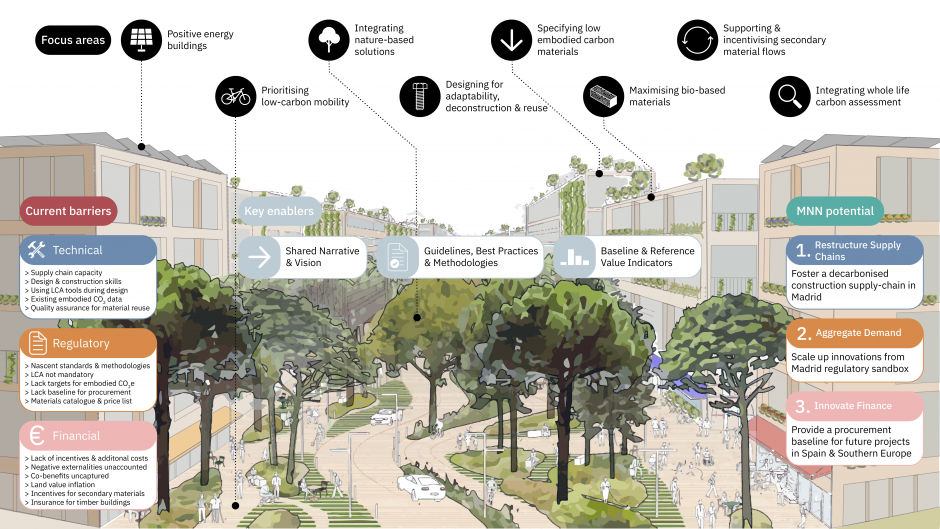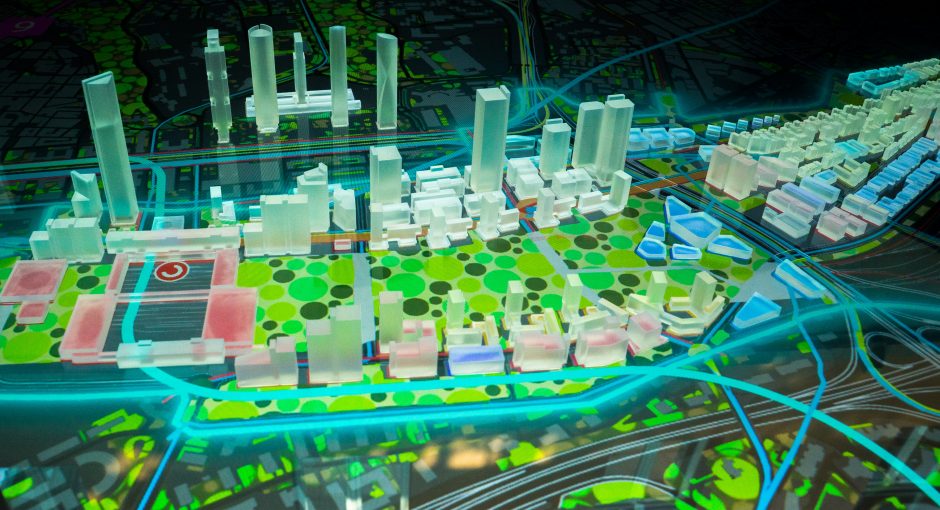Let’s tackle the carbon emissions hiding in plain sight: neutralising embodied carbon in buildings
Opinion
30 Nov 2021
Any practitioner on climate action knows the importance of addressing emissions from our buildings and construction, as they are significant contributors to climate change and account for 39 per cent of global greenhouse gas emissions. 28 per cent of these emissions originate from operational energy use, and 11 per cent represent embodied carbon – carbon emissions associated with materials and construction processes throughout the whole lifecycle.
As we begin to decarbonise our energy systems to meet our climate targets, the relevance of embodied carbon to reach net zero emissions will increase. The use of bio-based materials and the circular economy represent two major levers to address this. But how can we ensure strategies to reduce embodied carbon in buildings are implemented along the entire value chain, to have the highest mitigation potential?
As part of our Healthy, Clean Cities initiative, EIT Climate-KIC has been working with two of Europe’s leading design cities to test ways to dramatically reduce emissions embodied in the building materials for two of their urban regeneration developments: Madrid’s Nuevo Norte and Milan’s L’Innesto.
Around the world, the most climate-friendly builders are looking into the use of wood as the fundamental structure in buildings. A timber superstructure has the potential to reduce embodied emissions by a third, and more than half if we consider biogenic emissions (emissions locked up in the material that would otherwise be released as part of the tree’s lifecycle). These efforts present an economic opportunity for the mass timber sector and set a sustainable pathway for urban building construction.
The challenge of addressing embodied emissions in buildings is complex and fragmented. Building material supply chains are well-established, and changing practices among many actors is going to be hard. EIT Climate-KIC and its partners are committed to systemic approaches, and multi-stakeholder alignment will be critical to neutralise embodied carbon in buildings. We are exploring and driving multiple actions, taken simultaneously and collaboratively by (local) developers, policymakers, designers, financiers, and suppliers. A sector that is slow to change could be poised for accelerated adoption of bio-based materials and circularity in the built environment.
While a number of timber buildings have been built globally, the industry is still in its first steps when it comes to making such construction standard practice. Peer-to-peer learning and knowledge sharing between key stakeholders in the two cities is building collective intelligence and starting to identify concrete opportunities to overcome systemic barriers. Our effort accelerates learning through practical experimentation to explore levers of change and possible solutions. We are also setting out the needed leadership actions, such as commitments, outreach activities and communications, and supporting the creation of new partnerships and networks to build effective value chains.

Focus areas, current barriers, key enablers and potential for local interventions for systemic change towards bio-based, circular and embodied carbon neutral buildings in HCC EU CINCO’s Madrid testbed, Madrid Nuevo Norte. Image credits: Dark Matter Labs
After one year of working with the two cities, we know that one of the greatest barriers to the reduction of embodied carbon in buildings is the lack of robust, free, transparent, and official local Whole Life Carbon (WLC) data. A variety of different terms, definitions and standards are used in connection with greenhouse gas emissions from different stages of the lifecycle of products, buildings and infrastructure. To complicate things further, each may include different interpretations and meanings across different sectors of the market, and across countries and regions. Taking the definition adopted by WorldGBC, Whole Life Carbon (WLC) refers to emissions from all lifecycle phases, encompassing both embodied and operational carbon together.
The lack of robust datasets in turn causes a lack of confidence in stakeholders to set or support specific requirements, caps and targets. Promoting standardised approaches to WLC measurement and accounting will thus enable stakeholders to develop transparent and comparable local baselines and benchmarks. The International Organization for Standardization’s London Declaration – or “ISO’s Climate Commitment” is one step forward in this direction.
In response to this challenge, Healthy, Clean Cities is working with Spanish developer Distrito Castellana Norte (DCN) and the Municipality of Madrid to integrate environmental performance disclosures in tender documents for Madrid Nuevo Norte, EU’s largest new development. This could contribute to a local WLC dataset for use in future projects. One essential aspect of the initiative is to ensure that these datasets are open source, so that they can be used by other actors as well, for example, the city, for strategic policy developments.
The initiative is also working with DCN to define a standard for integrating WLC data in Building Information Modelling (BIM) software, making it possible for developers to understand and evaluate the impacts of material choices on the project’s environmental, technical and economic performance at once. To support increasingly complex multi-criteria evaluation, we created a preliminary decision-making tool for alternative construction materials and circularity enabling strategies, which will be tested by the Madrid developer during the procurement process.

Digital model of Madrid’s Nuevo Norte. Image credit: Distrito Castellana Norte
One of the great benefits of this ‘learning-by-doing’ approach is that the generated knowledge can be transferred to others: we are now exploring how similar processes can be adopted in Milan’s L’Innesto with developer REDO.
WLC datasets will be central to the policy tools needed by cities to govern the neutralisation of embodied carbon in buildings: both existing ones, such as urban planning regulation, list of prices, and other instruments (an area we are working on with the municipality of Madrid) and new ones, such as material passports (which we are exploring in Milan in collaboration with the Carbon-Neutral Areas Working Group of the strategic policy tool ‘Piano Aria Clima’).
Material passports need an implementation vehicle that integrates the needs and interests of several stakeholders and ultimately attract sources of capital throughout the value chain, from sustainable forestry and value-added production facilities to contractors capable of delivering quality in the marketplace. Our partner, Material Economics, completed an economic analysis to determine that mass timber in construction can be a cost-effective way of reducing carbon emissions, as it is roughly cost-neutral in Europe compared to a steel/concrete building, but the economic impact may not be evenly distributed along the value chain, with certain stakeholders benefiting more than others.

CGI photo of Milan’s L’Innesto. Photo credit: REDO
Of course, the timber used in buildings should be sustainably sourced. According to the State of Europe’s Forests 2020, as of 2015 only 9 per cent of Italian forests were certified, mostly via Programme for the Endorsement of Forest Certification (PEFC). Healthy, Clean Cities is talking to timber certification organisations about how they can promote sustainable forestry practices and quantify environmental benefits of timber use in construction products, for example via the EU Forest Strategy and Construction Product Regulations, to ensure that sources of mass timber are behaving as a carbon sink, while not destroying biodiversity or the other services that forests provide, for example leisure and tourism.
In conclusion, we cannot decarbonise the built environment without considering a complex system in which policy, capital, and project scales all interact. Doing that demands that we build new capabilities and push boundaries with businesses, finance partners and city governments simultaneously. In this context, Laudes’ Accelerator Fund Built by Nature is a convening and funding power that will enable a revolution in the way we think about innovation for climate action. One of the most interesting things we are learning is that once this approach begins, it leads to actions no one could have anticipated. The path to net-zero carbon requires a focus on innovation shaped to learn about what we do not yet know, rather than trying to do what we already know as fast as we can.
Dr.-Ing. Mira Conci is an Italian architect and engineer specialised in systemic approaches to sustainable development in cities. At EIT Climate-KIC she manages and orchestrates the Healthy, Clean Cities initiative, and provides content and strategy to the H2020 NetZeroCities project.




